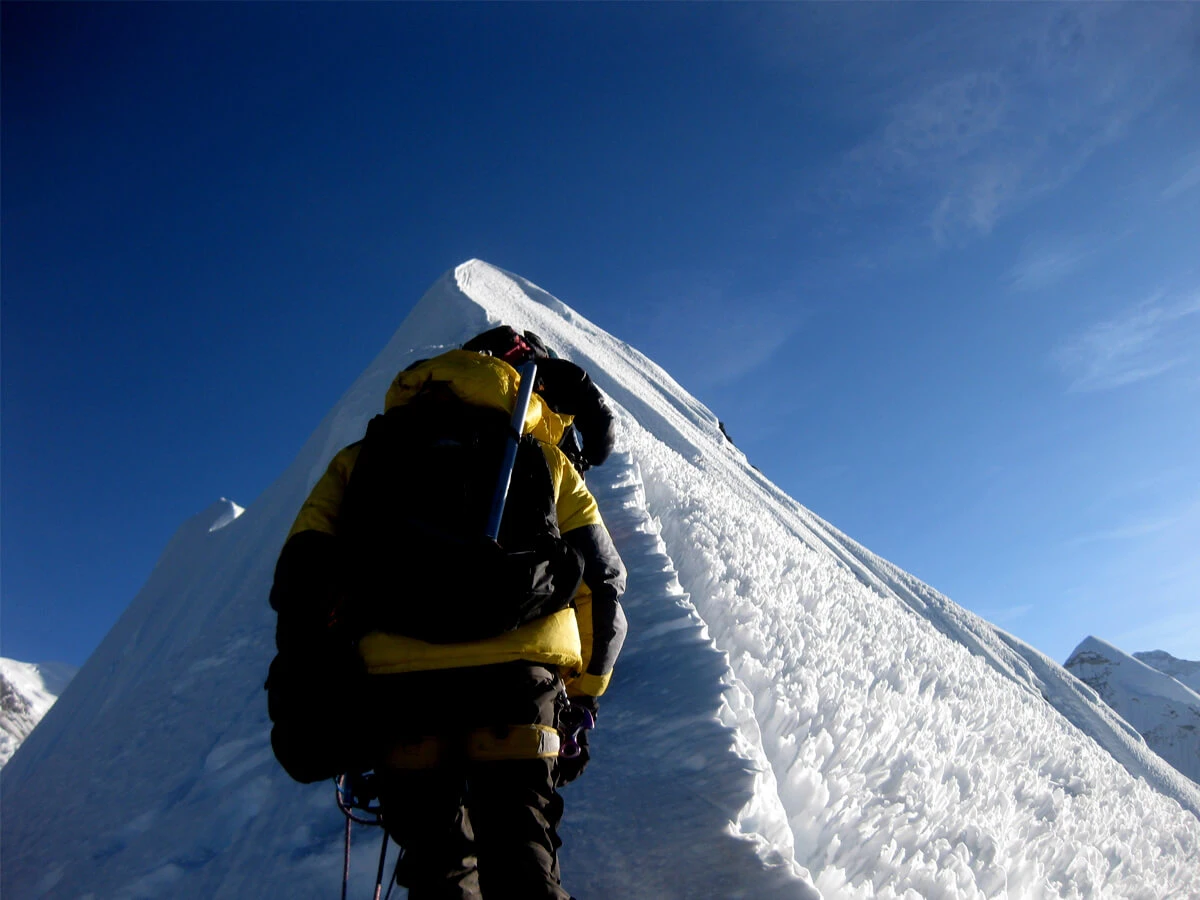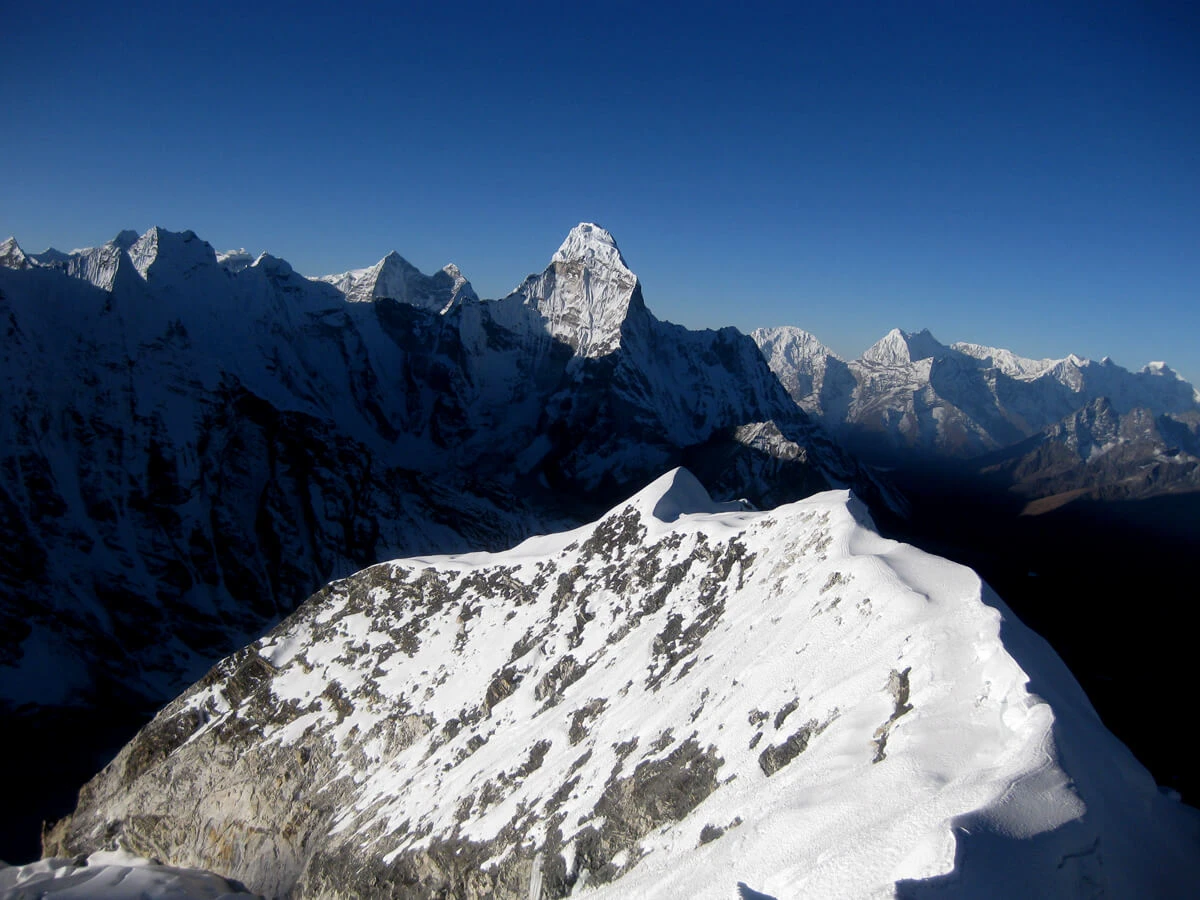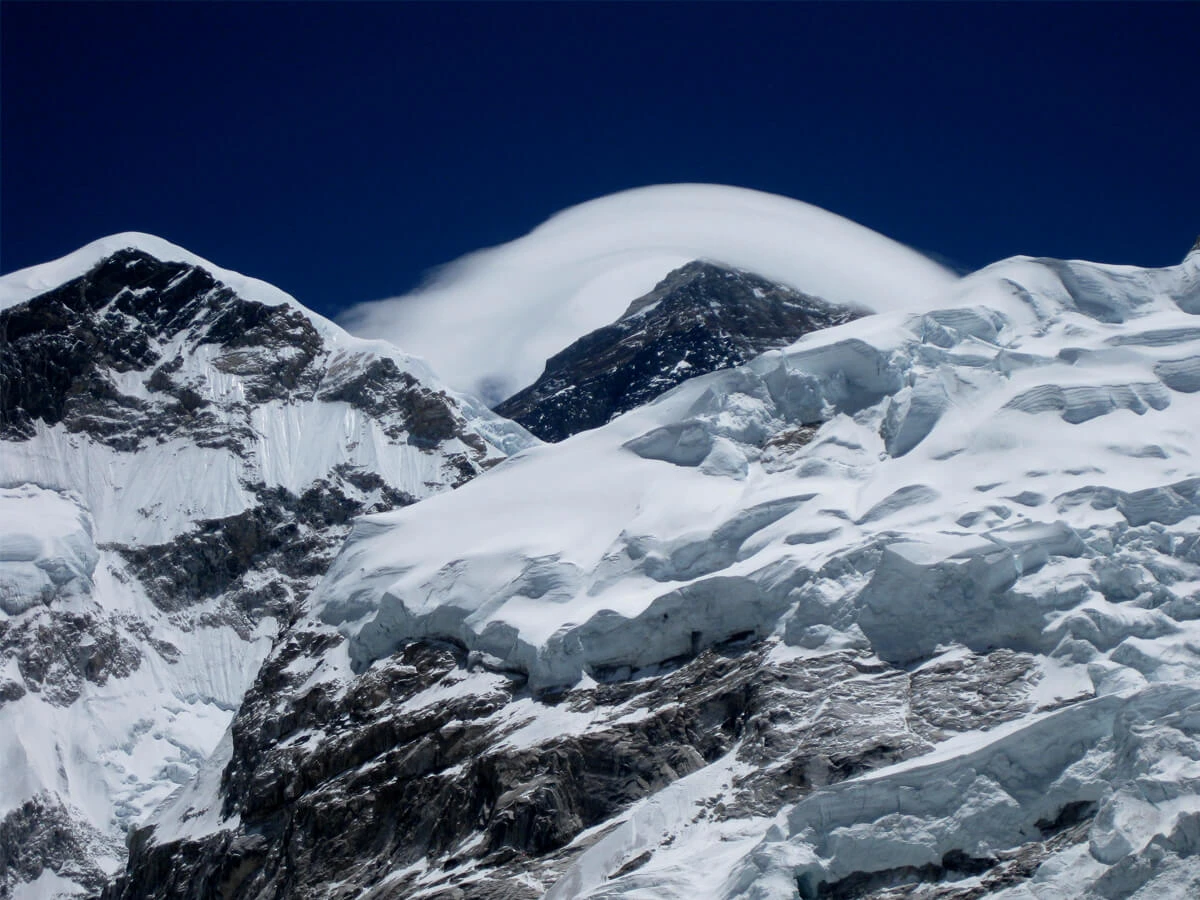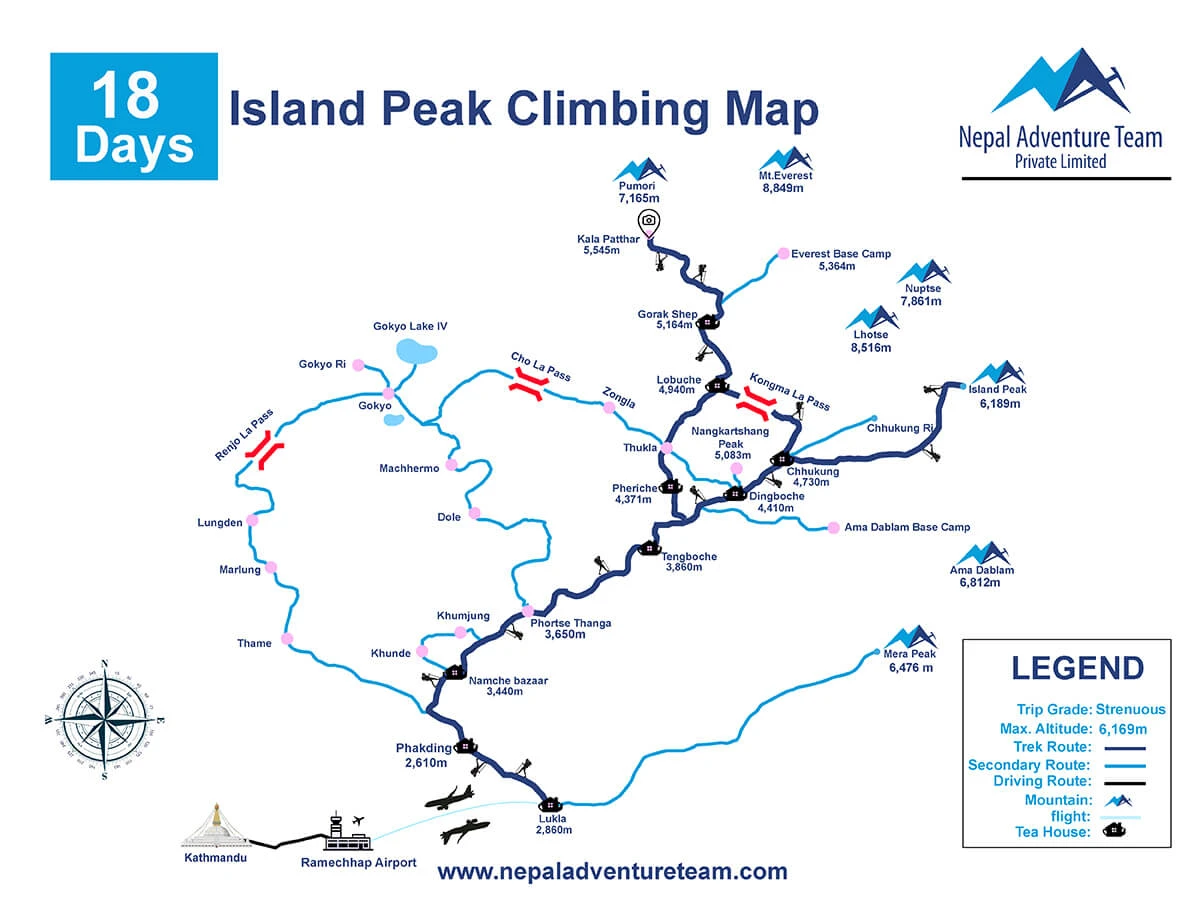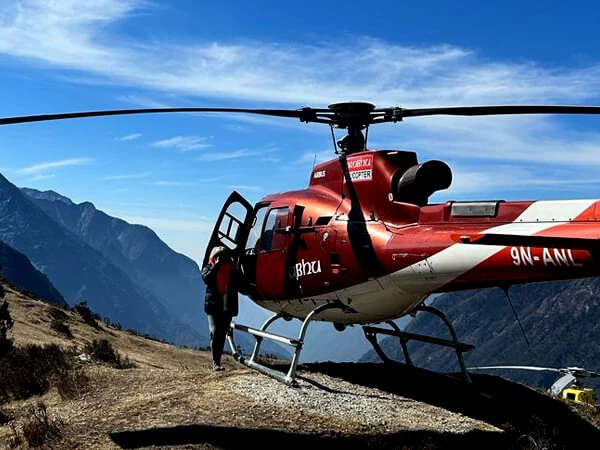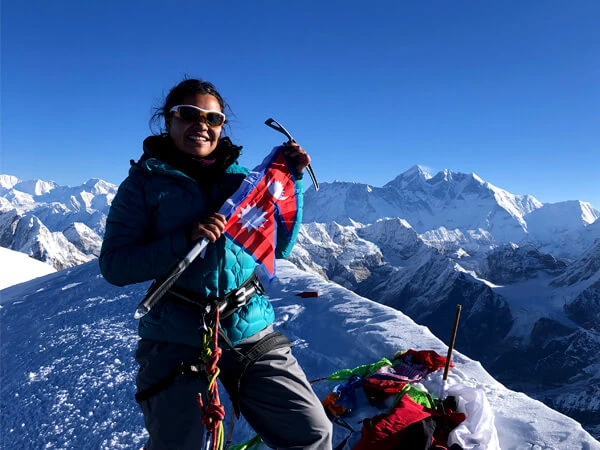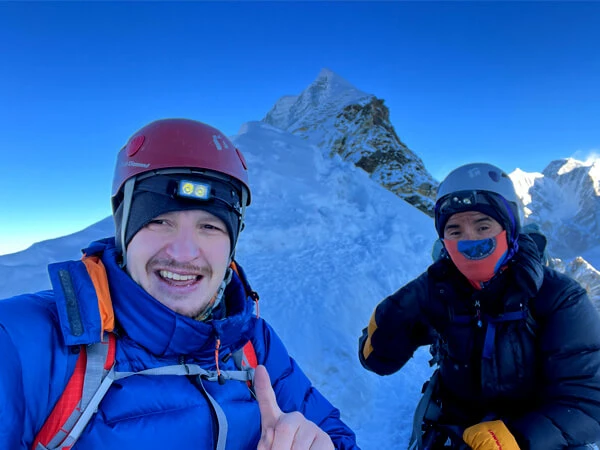Island Peak Climbing is one of the most adventurous and popular peak climbing packages in Nepal, which not only takes you to the summit of magnificent Island Peak (6189) but also lets you experience the once-in-a-lifetime trekking experience in the Everest region. Following the world-famous Everest Base Camp trekking trails, besides summiting the Island Peak Climbing, it rewards you with the phenomenal trek to the Everest Base Camp and a hike to one of the top magnificent vantage points in Nepal-Kalapathar.
Our 18-day Island Peak Climbing begins with flying to Lukla from Kathmandu. With a scenic flight to Lukla, a gateway to the Everest region, your adventurous journey heads towards the famous small town of Namche Bazaar (Information) to acclimatize. After Namche Bazaar, you will stop at Pheriche and Island Peak Base Camp to acclimatize, which will help you avoid acute mountain sickness. On your way, you will experience the rich culture of the infamous Sherpa people and their lifestyle, adorned with beautiful settlements, diverse landscapes, and the exotic flora and fauna of the Sagarmatha National Park. Island Peak climbing is preferable for both experienced and less experienced climbers. If you are not having enough of the Mount Everest region, then choose the Island Peak Climbing with Nepal Adventure Team, where you can taste the flavor of mountain climbing, along with the natural and cultural aspects of the Khumbu Valley.
Island Peak (Imja Tse Peaks)
Island Peak, also known as Imja Tse Peak, is located in the eastern Himalayas of the Sagarmatha National Park. Island Peak, also known as the Imja Tse Peak, is at an altitude of 6189 meters. The Peak was named Island Peak in 1953 by members of the British Mount Everest Expedition. It was named Island Peak due to its appearance as an island on a sea of ice from Dingboche. Island Peak is an extension of the ridge coming down from Lhotse. You can have marvelous views of Mount Lhotse, Shar, Nuptse, Ama Dablam, and Makalu from the summit of Island Peak, but Island Peak itself is not visible until you reach Dingboche.
Everest Base Camp
Besides summiting the most popular Island Peak, a star attraction of this Island Peak climbing is trekking to the Everest Base Camp (5,364 m). Island Peak Climbing gives you the perfect opportunity to reach the Everest Base Camp and hike to Kalapatthar, where you can have up-close stunning views of the highest mountain in the world, Mount Everest, including Mt. Nuptse, Mt. Changtse, Mt. Lhotse, and Mt. Pumori.
Traversing through the Sagarmatha National Park, the Island Peak climbing route takes you to the Everest Base Camp in Nepal. It takes you to the beautiful Namche Bazaar, where you can observe the infamous Sherpa culture, great mountain views, and landscapes. Even though the Island Peak Climbing route’s ultimate destination is reaching the summit of Island Peak, the other peculiar stations, such as Lukla Village, Namche, and Kalapathar, make this Island Peak climbing more exciting and thrilling. It lets you have the real jewels of the Khumbu Valley.
Island Peak Climbing Difficulties
This peak was first climbed for training exercise by a British Expedition that went on to summit Mount Everest. It requires moderate scrambling from base camp to high camp. Although Island Peak is easier to climb compared to other peaks in the Everest region, it is a physically demanding climb due to its steep climbing. The first and foremost danger you are going to face is altitude sickness, also known as Acute Mountain Sickness. It occurs due to a lack of oxygen at higher levels where your body can’t adjust itself to the gradually changing altitudes. With our carefully planned itinerary, the chances of altitude sickness are lowered. If you follow the instructions of your expert leaders, then you will easily overcome the difficulties. It is a challenging climb that requires excellent knowledge of snow climbing skills and a good knowledge of Nepal Peak climbing equipment and checklist.
On top of that, it demands a copious amount of physical fitness. Therefore, we don’t recommend Island Peak climbing if you are a beginner at mountain climbing.
Best Time for Island Peak Climbing
The best time for Island Peak Climbing (2025) is the autumn season from September to November and the spring season from March to May. You can get breathtaking mountain views on clear weather. Because of this, it is considered a peak season for climbing and trekking in Nepal. During these peak times, the Island Peak Climbing trail is crowded with mountain climbers and trekkers from all around the world.
However, due to the heavy snowfall and freezing temperatures, Island Peak climbing in winter is complicated and risky, whereas the heavy rainfall monsoon isn’t the best time for Island Peak Climbing. However, this doesn’t mean you can’t climb Island Peak in winter and the monsoon season. With proper mountain climbing experience, proper training, and climbing techniques, along with knowledge of equipment and precautions, Island Peak Climbing is possible all year.
Island Peak Climbing Permits
About the permits, Nepal adventure Team will provide you with all the necessary Island Peak Climbing (2025) permits, but if you are wondering what permits are needed for Island Peak Climbing, then we have listed below all the permits required for you.
- Nepal Mountaineering Association(NMA) Permit
- Sagarmatha National Park Entry Permit
- Local Area Permit
- TIMS Card (Trekkers Information Management System)
Highlights
- Summit Island peaks at an altitude of 6189 meters in the Everest region
- Enjoy walking through the Sagarmatha National Park with rich flora and fauna
- Observe the rich Sherpa culture and unique lifestyle of the Sherpa people in charming villages such as Namche Bazaar, Tengboche, Dingboche, and many others
- Grab the majestic views of Mount Everest, Mt.Nupse, Mt.Lhotse, Mt.Makalu, and Mt. Ama Dablam
- Hike to one of the top magnificent vantage points, Kalapathar, from Gorakshep, and trek to Chhukung Ri
